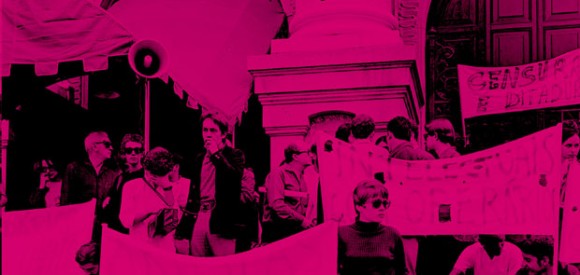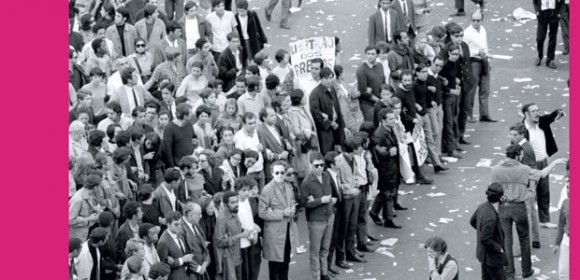
O Globo ArchiveArtists during a manifestation against the dictatorshipO Globo Archive
The concept of cultural resistance was a type of umbrella of artistic and cultural production of opposition to the Brazilian military regime. It harbored a series of tones and compositions whose dynamic even today demands research and more precise definitions. After various studies on the articulations and paradoxes between political engagement and cultural industry, above all in the fields of popular music and audiovisual production, historian Marcos Napolitano, a professor at the School of Philosophy, Literature and Human Sciences (FFLCH) at the University of São Paulo (USP), has just defended his thesis on the cultural policies that were born out of or developed within this culture of opposition during the most characteristic period of the authoritarian cycle.
The title of the thesis is Coração civil: arte, resistência e lutas culturais durante o regime militar brasileiro (1964-1968) [Civil heart: art, resistance and cultural struggles during the Brazilian military regime] resulted from a research project carried out with the support of the National Council of Scientific and Technological Development (CNPq). The expression “civil heart” had already been used by the author in his studies on MPB [popular Brazilian music] to allude to a feeling of opposition that permeated the hegemonically Left wing, cultural production, as well as its fruition and value by an educated middle class. The dilemmas and contradictions of culture, principally in the artistic works, also expressed “the dilemmas and contradictions of this same civil resistance.”
In his new study, Napolitano analyzes the cultural policies and actions of four currents of cultural resistance to the regime: communists (understood as intellectuals linked to the Brazilian Communist Party – PCB), Catholics, liberals and counter-cultural movements. As his central hypothesis the author worked with the perception that a strategic alliance between liberals and communists produced the dominant concept of cultural resistance, which came into conflict with movements linked to the Roman Catholic church and counter-cultural trends.
The latter two trends, even though very dissimilar in various senses, had in common a radically critical stance with regard to some pillars of the traditional culture of the Left. Between these pillars Napolitano emphasizes, above all, the participation of opposition artists in the great production market of symbolic goods, the realistic esthetic supported in a “cultural hierarchy legitimized by the institutions” and the “role of the intellectual as a central mediator of culture.” The first point was illustrated, and already intensely discussed at the time, by the migration of dramatists linked to the PCB (like Dias Gomes and Oduvaldo Vianna Filho) to Rede Globo [TV network], at the beginning of the 1970’s. The two other instances of conflict had to do with the crucial question of how to speak in the name of the popular classes and if this was possible and legitimate. Napolitano underlines that in this aspect the criticisms formulated by the Catholic Left and the counter-culture were very different. While the former defended “a basist, amateur and community culture,” the latter proposed “a sectarian, experimental and transgressor culture.” Both tried to distance themselves from, or at least question, the conventional spaces and institutions of production and cultural consumption. Examples of this were the theaters on the outskirts, the outlying cinemas and a certain feature of tropicalism, insulting good taste and conceptual art, which was exercised outside the circuits of museums and galleries.
Napolitano sees his study, in part, as a return to themes “well-established by the historiography of Brazilian culture,” but with an important, new element. “The great gap, in my opinion, is the theme of cultural policies linked to the new Left, formed by democratic socialists, Leninist dissidents, basic social movements, the Catholic Left and others,” says the historian. “What I did in my work was basically to collate the analyses that had already been proposed with new sources and new perspectives, analyzing above all the view and role of culture for each major ideological group that was in opposition to the regime.” Among the intellectuals who dedicated themselves to the study of the cultural struggle between communists and counterculture, Napolitano cites Roberto Schwarz, Heloisa Buarque de Hollanda and Celso Favaretto. The study of liberals, understood to be “groups linked to the impresarios of culture and the press,” was, he remembers, mapped out by those authors who analyzed the industry of culture, like Renato Ortiz and Sergio Miceli.
In the work he has been doing, at least since his PhD, with the thesis Seguindo a canção: engajamento político e indústria cultural na trajetória da música popular brasileira – 1959/1969 [Following the song: political engagement and the culture industry in popular Brazilian music] (published as a book by Annablume/FAPESP in 2001), Napolitano also emphasizes the importance of the work, Em busca do povo brasileiro [Searching for the Brazilian people] (Record publishing house, 2000) by historian Marcelo Ridenti, in exploring the relationship between culture, ideology and politics. The book studies the imaginary of artists and intellectuals of the Left based on the middle classes, particularly in the 1960’s. The author characterizes this imaginary as pervaded by a super-dimensioned category of the “people,” a late manifestation of “revolutionary Romanticism.” “This was a bet on the possibilities of a Brazilian revolution that would allow the potential of a people and a nation to be realized,” says Ridenti, a professor from Unicamp and coordinator of Human and Social Sciences for FAPESP. “The representations of the mixture of white, black and Indian that were so dear, for example, to the thinking of Gilberto Freyre, were recovered in the constitution of ‘Brazilianess’. Except now it was no longer in the sense of justifying the existing social order, but questioning it. Brazil would not yet be the country of racial integration, of harmony and of happy people, because this would be forbidden by the power of the landlords, by imperialism and, in the extreme, by capital.”

O Globo ArchiveCulture in the demonstration of the 100,000O Globo Archive
In this context the strategic questions of the proposals of cultural politics that Napolitano studied for his associate professor qualification thesis (based exclusively on text sources from the time) have “the ‘cultural fronts’ of resistance that were almost always defended by the communists with, at times, the support of liberal sectors” as their unavoidable point of reference. “This alliance was guided by a concept of Brazilian culture and cultural action that was questioned by the counter-culture groups and, from another viewpoint, by the new Left, which as from 1980 merged with the PT [Labor Party],” says Napolitano.
Because of the important presence of groups linked to the PCB in Brazilian cultural life the study of the intellectual production of the military period cannot dispense with a reversion to previous decades. If the party, in the words of sociologist Rodrigo Czajka, “had had no decision-making importance since 1947, when it was forced underground,” there was a reconfiguration of the intellectual front line in the following decade, when international Communism went through a crisis “and these intellectuals and artists started to become inserted into various arenas of Brazilian cultural production.”
Miceli, a full professor of the Department of Social Sciences at FFLCH-USP and author of classic works like Intelectuais e classe dirigente no Brasil (1920-1945) [Intellectuals and the ruling class in Brazil], sees the coopting by the authorities as an historical constant in the culture of the country. “Unlike what happened in Argentina and Chile, the Brazilian military regime did not dismantle the institutional foundations of intellectual life, like public universities, the publishing system, corporate entities, etc.,” he says. “On the other hand, the intellectual Left, even at the most difficult moment of repression, never lost its condition of legitimacy, as an arbiter in cultural matters.”
Czajka, who is a professor at the Federal University of Vale do Jequitinhonha and Mucuri (MG), devoted his Master’s thesis at Unicamp to studying the actions of Ênio Silveira at the head of publishing house, Civilização Brasileira, and particularly of the Revista Civilização Brasileira [magazine], in which he intended to explore the complexity of the intellectual hegemony of the Left in the 1960’s. “Ênio brought together two apparently contradictory aspects: militancy and market,” says the sociologist. “From this appeared other issues that evoke, for example, the approximation of the PCB to new forms of public visibility. The market, in its turn, welcomed new languages and enabled the emergence of new social players.” As additional information about the ambiguity of the position of the magazine, Czajka recalls that Silveira resisted pressure from the PCB for the magazine to become part of the group of publications of the party and that the editor himself was a member of the party, although he never revealed this publicly.
As the military regime advanced, the question of the culture industry gained weight in the debates in the culture of the opposition. “I try and show that the problem was already there at the end of the 60’s, but it is undeniable that the culture industry made a qualitative leap towards a ‘system’ during the following decade,” observes Napolitano. “The military regime undertook a process of authoritarian modernization of Brazilian society,” says Ridenti, who points out the double role of the State, as censor and motivator of culture (via, for example, official support for Embrafilme in the cinema, often with film-makers from the Left). “It was in this period that Rede Globo was set up, with incentives from the regime, placing the question of national cultural identity in the sphere of the market of symbolic goods.” Napolitano does not see this progression as a defeat for the ideas of the Left. “If there was, at times, restrictive pressure on producers and artists, we cannot forget that the key of the ‘resistance’ also engaged the public or consolidated market trends. On the other hand the culture of opposition played a formative role, a type of civic and sentimental education that encompassed broad sectors of the population.”
Republish